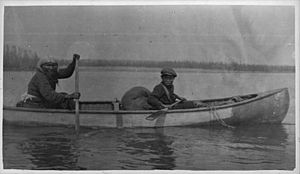Dene facts for kids
The Dene people (/ˈdɛneɪ/) are an indigenous group of First Nations who inhabit the northern boreal and Arctic regions of Canada. The Dene speak Northern Athabaskan languages. Dene is the common Athabaskan word for "people". The term "Dene" has two usages. More commonly, it is used narrowly to refer to the Athabaskan speakers of the Northwest Territories and Nunavut in Canada, especially including the Chipewyan (Denesuline), Tlicho (Dogrib), Yellowknives (T'atsaot'ine), Slavey (Deh Gah Got'ine or Deh Cho), and Sahtu (the Eastern group in Jeff Leer's classification; part of the Northwestern Canada group in Keren Rice's classification). However, it is sometimes also used to refer to all Northern Athabaskan speakers, who are spread in a wide range all across Alaska and northern Canada. The Southern Athabaskan speakers, however, also refer to themselves by similar words: Diné (Navajo) and Indé (Apache).
Contents
Location
Dene are spread through a wide region. They live in the Mackenzie Valley (south of the Inuvialuit), and can be found west of Nunavut. Their homeland reaches to western Yukon, and the northern part of British Columbia, Alberta, Saskatchewan, Manitoba, Alaska and the southwestern United States. Dene were the first people to settle in what is now the Northwest Territories. In northern Canada, historically there were ethnic feuds between the Dene and the Inuit. In 1996, Dene and Inuit representatives participated in a healing ceremony to reconcile the centuries-old grievances.
Behchoko, Northwest Territories is the largest Dene community in Canada.
Ethnography
The Dene include five main groups:
- Chipewyan (Denesuline), living east of Great Slave Lake, and including the Sayisi Dene living at Tadoule Lake, Manitoba
- Tlicho (Dogrib), living between Great Slave and Great Bear Lakes
- Yellowknives (T'atsaot'ine), living north of Great Slave Lake
- Slavey (Deh Gah Got'ine or Deh Cho), the North Slavey (Sahtu, (Sahtúot’ine), including the Locheux, Nahanni, and Bear Lake peoples) living along the Mackenzie River (Deh Cho) near Great Bear Lake, the South Slavey southwest of Great Slave Lake and into Alberta and British Columbia.
- Sahtu (Sahtúot’ine), including the Locheux, Nahanni, and Bear Lake peoples, in the central NWT.
Although the above-named groups are what the term "Dene" usually refers to in modern usage, other groups who consider themselves Dene include:
- Tsuu T'ina, aka the Sarcee, currently located near Calgary, Alberta.
- The Beaver people (Danezaa or Dunneza) of northeastern British Columbia and neighbouring regions of northwestern Alberta.
- The Tahltan, Kaska, and Sekani people of the Northern Interior of British Columbia. Another group in this region, the Tsetsaut people, lived in the Portland Canal area of the northernmost BC Coast near the border with Alaska. They are now extinct.
- The Dakelh (Carrier) peoples of the Northern and Central Interior of British Columbia, and their subgroup the Wet'suwet'en
- The Tsilhqot'in people of the eponymous Chilcotin District of the Central Interior of British Columbia
- The extinct Nicola Athapaskans, aka the Stuwix ("strangers" in the Shuswap language), migrated south from northern BC into the Nicola Valley region in the late 18th century and were absorbed into the Nicola people, an alliance of Nlaka'pamux and Okanagan peoples.
- The Gwich'in and Tanana and other peoples of Yukon and Alaska are also considered to be Dene, which is to say part of the family of Athapaskan-speaking peoples.
In 2005, elders from the Dene People decided to join the Unrepresented Nations and Peoples Organisation (UNPO) seeking recognition for their ancestral cultural and land rights.
The largest population of Denesuline speakers live in the northern Saskatchewan village of La Loche and the adjoining Clearwater River Dene Nation. In 2011 the combined population was 3389 people. The Denesuline language is spoken by 89% of the residents.
Notable Dene
- Thanadelthur (c. 1697 – 5 February 1717) a woman of the Chipewyan Nation, a guide and interpreter, who was instrumental in forging a peace agreement between the Chipewyan and the Cree people
- Ethel Blondin-Andrew, former MP for Western Arctic (Northwest Territories)
- Leela Gilday, Canadian folk singer, Juno winner
- Jimmy Herman (1940-2013) actor, Dances with Wolves
- Matonabbee (c. 1737–1782), guide for Samuel Hearne's expedition to the Coppermine River
- Tahmoh Penikett, actor, Battlestar Galactica and Dollhouse
- Eric Schweig, actor, The Last of the Mohicans
- Jim Boucher, politician, businessman
- Shannon Smallwood, justice of the Supreme Court of the Northwest Territories
- Be'sha Blondin, elder and founder of the Arctic Indigenous Wellness Foundation
See also
 In Spanish: Dene para niños
In Spanish: Dene para niños
- Athabaskan languages
- Alaskan Athabaskans (Alaskan Dene, Tinneh), Athabaskan peoples of the interior of Alaska
- Navajo Nation (Diné), southern Athabaskan people
- Apache people (Inde), southern Athabaskan people
- Hupa, California Athabaskan people
- Cahto people, California Athabaskan people
- Mattole people, California Athabaskan people
- Wailaki, California Athabaskan people
- Galice language-speakers (Oregon Athabaskan): Chetco, Tolowa, Coquille, Tututni


